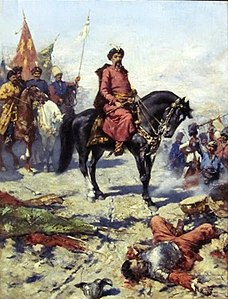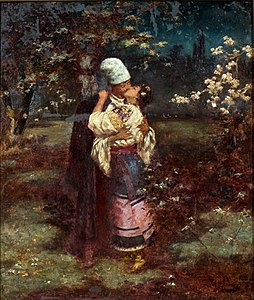Mykola Ivasyuk: Difference between revisions
No edit summary |
|||
| (8 intermediate revisions by 5 users not shown) | |||
| Line 8: | Line 8: | ||
While there, he participated in student excursions to the [[Ternopil]] region, where he became acquainted with the nobleman, {{ill|Volodyslav Fyodorovych|uk|Федорович Володислав Іванович}} and painted portraits of his family. After graduating, he was recommended to the [[Academy of Fine Arts, Munich]], to complete his education.<ref name="uahistory.com">{{Cite web|url=http://uahistory.com/topics/famous_people/4537|title=Маестро історичного живопису - UAHistory|date=2016-04-29|website=UAHistory|language=uk-UA|access-date=2016-05-10}}</ref> While there, he met the Russian artist, [[Ilya Repin]], who advised him to establish himself in Kyiv. |
While there, he participated in student excursions to the [[Ternopil]] region, where he became acquainted with the nobleman, {{ill|Volodyslav Fyodorovych|uk|Федорович Володислав Іванович}} and painted portraits of his family. After graduating, he was recommended to the [[Academy of Fine Arts, Munich]], to complete his education.<ref name="uahistory.com">{{Cite web|url=http://uahistory.com/topics/famous_people/4537|title=Маестро історичного живопису - UAHistory|date=2016-04-29|website=UAHistory|language=uk-UA|access-date=2016-05-10}}</ref> While there, he met the Russian artist, [[Ilya Repin]], who advised him to establish himself in Kyiv. |
||
[[File:Учасники з’їзду українських письменників з нагоди 100-річчя виходу в світ «Енеїди».jpeg|thumb|The board and members of the [[Shevchenko Scientific Society]] celebrating the 100th anniversary of the publication of [[Ivan Kotliarevsky|Ivan Kotliarevsky's]] [[Eneida]], [[Lviv]], 31 October 1898: Sitting in the first row: Mykhaylo Pavlyk, [[Yevheniya Yaroshynska]], [[Nataliya Kobrynska|Natalia Kobrynska]], [[Olha Kobylianska]], Sylvester Lepky, Andriy Chaykovsky, Kost Pankivsky. In the second row: Ivan Kopach, [[Volodymyr Hnatiuk]], Osyp Makovej, [[Mykhailo Hrushevsky]], [[Ivan Franko]], Oleksandr Kolessa, [[Bohdan Lepky]]. Standing in the third row: Ivan Petrushevych, [[Filaret Kolessa]], Yossyp Kyshakevych, [[Ivan Trush]], Denys Lukianovych, Mykola Ivasyuk.]] |
|||
| ⚫ | |||
He held his first exhibition in Chernivtsi, where he displayed genre works as well as historical scenes. In 1899, he established a school there for "talented but poor youth", which he operated until 1908, when he took Repin's advice about Kyiv. Just prior to World War I, however, the government of [[Bukovina]] offered him the sum of 1000 [[Austrian krone|Crowns]] to establish another art school in Chernivtsi, so he returned. He also opened a workshop for [[icon painting]]. It was there that he executed his most famous work; "The Entrance of [[Bohdan Khmelnytsky]] to Kyiv in 1649", a reproduction of which was once a common sight in Ukrainian homes. As a supporter of Ukrainian independence, he created many similar paintings, but most of them were lost years later when he once again went to Kyiv. |
|||
| ⚫ | |||
In 1919, the [[Directorate of Ukraine]] commissioned him to design postage stamps for the [[Ukrainian People's Republic]]. He produced fourteen designs altogether and they were printed in 1921 but, shortly after, the Soviets took control of Ukraine and they were never used. |
In 1919, the [[Directorate of Ukraine]] commissioned him to design postage stamps for the [[Ukrainian People's Republic]]. He produced fourteen designs altogether and they were printed in 1921 but, shortly after, the Soviets took control of Ukraine and they were never used. |
||
In 1926 [[Vlas Chubar]], Chairman of the People's Commissariat of Ukraine, invited him and his student, {{ill|Evzebiy Lipetskiy|uk|Ліпецький Євзебій Олександрович}}, to become professors at the [[National Academy of Visual Arts and Architecture|Kyiv Art Institute]]. Lipetskiy was wary of the Soviets and refused the offer; advising Ivasyuk to do the same. He accepted, however, and moved his family there the same year. They were immediately granted Soviet citizenship. |
In 1926 [[Vlas Chubar]], Chairman of the People's Commissariat of Ukraine, invited him and his student, {{ill|Evzebiy Lipetskiy|uk|Ліпецький Євзебій Олександрович}}, to become professors at the [[National Academy of Visual Arts and Architecture|Kyiv Art Institute]]. Lipetskiy was wary of the Soviets and refused the offer; advising Ivasyuk to do the same. He accepted, however, and moved his family there the same year. They were immediately granted Soviet citizenship. |
||
| ⚫ | |||
At first, he was honored and praised but soon, following instructions from Moscow, he began to be criticized; initially for small things, then for more serious matters. Eventually, he was transferred to [[Odessa]], where he came under harsh criticism for "bourgeois deviations". Finally, it was forbidden to mention his name.<ref name="uahistory.com"/> In September, 1937, the [[NKVD]] conducted a search of his apartment and found nothing incriminating. He was arrested, nevertheless, and taken to [[Lukyanivska Prison]]. |
At first, he was honored and praised but soon, following instructions from Moscow, he began to be criticized; initially for small things, then for more serious matters. Eventually, he was transferred to [[Odessa]], where he came under harsh criticism for "bourgeois deviations". Finally, it was forbidden to mention his name.<ref name="uahistory.com"/> In September, 1937, the [[NKVD]] conducted a search of his apartment and found nothing incriminating. He was arrested, nevertheless, and taken to [[Lukyanivska Prison]]. |
||
The following month, he was formally accused of being a terrorist and an agent of German intelligence. He refused to confess. In November, he was convicted and, eleven days later, executed by firing squad. All of his personal property was confiscated and destroyed.<ref>[http://www.history.org.ua/?l=EHU&verbvar=Ivasjuk_M&abcvar=11&bbcvar=3 Стаття на сайті Інститут історії України НАНУ]</ref> His remains were returned to Bukovina.<ref>{{Cite web |url=http://memorial.kiev.ua/content/view/166/70/ |title=Архівована копія |archive-url=https://web.archive.org/web/20110723173738/http://memorial.kiev.ua/content/view/166/70/ |archive-date=23 July 2011 |url-status=dead }}</ref> He was rehabilitated in 1980.<ref> |
The following month, he was formally accused of being a terrorist and an agent of German intelligence. He refused to confess. In November, he was convicted and, eleven days later, executed by firing squad. All of his personal property was confiscated and destroyed.<ref>[http://www.history.org.ua/?l=EHU&verbvar=Ivasjuk_M&abcvar=11&bbcvar=3 Стаття на сайті Інститут історії України НАНУ]</ref> His remains were returned to Bukovina.<ref>{{Cite web |url=http://memorial.kiev.ua/content/view/166/70/ |title=Архівована копія |archive-url=https://web.archive.org/web/20110723173738/http://memorial.kiev.ua/content/view/166/70/ |archive-date=23 July 2011 |url-status=dead }}</ref> He was rehabilitated in 1980.<ref>Орлик М. [http://gromady.cv.ua/zt/news/21749/ ''The Long Road to Rehabilitation''], [https://web.archive.org/web/20190224173523/ Web Archive] [http://gromady.cv.ua/zt/news/21749/ Gromady]</ref> |
||
==Selected paintings== |
|||
<gallery mode=packed heights=200> |
|||
Микола Івасюк. Богдан Хмельницький.jpg|Bohdan Khmelnytsky<br>in Battle |
|||
Микола Івасюк. Поцілунок.jpg|The Kiss |
|||
| ⚫ | |||
Мати. Художник М.Івасюк. 1908 р.jpg|The Mother |
|||
Микола Івасюк. Богун на переправі.jpg|[[Ivan Bohun]] at the [[Battle of Beresteczko]] |
|||
</gallery> |
|||
== References == |
== References == |
||
{{reflist}} |
{{reflist}} |
||
{{hatnote|This article contains text translated from Ukrainian Wikipedia}} |
|||
== External links == |
== External links == |
||
| Line 34: | Line 45: | ||
[[Category:1937 deaths]] |
[[Category:1937 deaths]] |
||
[[Category:Ukrainian male painters]] |
[[Category:Ukrainian male painters]] |
||
[[Category:People from the Duchy of Bukovina]] |
|||
[[Category:History painters]] |
[[Category:History painters]] |
||
[[Category:Executed Ukrainian people]] |
[[Category:Executed Ukrainian people]] |
||
Latest revision as of 13:27, 16 October 2024

Mykola Ivanovych Ivasyuk (Ukrainian: Мико́ла Іва́нович Івасю́к: 28 July 1865, Zastavna, Duchy of Bukovina — 25 November 1937, Kyiv) was a Ukrainian painter executed during the Great Purge. He specialized in history painting, but is also known for his postage stamp designs.
Biography
[edit]His father was a carpenter. At the time of his birth, Zastavna, Duchy of Bukovina was part of Austrian Empire, which became the Austro-Hungarian Empire two years later. Due to this his primary education was conducted in German and Romanian. For his secondary studies, he went to Chernivtsi. One of his instructors there was the Ukrainian artist Yustyn Pigulyak, who discovered and encouraged his talent for art by giving him free lessons. Before long, he had decided to become a history painter. In 1884, he was able to gain admission to the Academy of Fine Arts, Vienna.
While there, he participated in student excursions to the Ternopil region, where he became acquainted with the nobleman, Volodyslav Fyodorovych and painted portraits of his family. After graduating, he was recommended to the Academy of Fine Arts, Munich, to complete his education.[1] While there, he met the Russian artist, Ilya Repin, who advised him to establish himself in Kyiv.

He held his first exhibition in Chernivtsi, where he displayed genre works as well as historical scenes. In 1899, he established a school there for "talented but poor youth", which he operated until 1908, when he took Repin's advice about Kyiv. Just prior to World War I, however, the government of Bukovina offered him the sum of 1000 Crowns to establish another art school in Chernivtsi, so he returned. He also opened a workshop for icon painting. It was there that he executed his most famous work; "The Entrance of Bohdan Khmelnytsky to Kyiv in 1649", a reproduction of which was once a common sight in Ukrainian homes. As a supporter of Ukrainian independence, he created many similar paintings, but most of them were lost years later when he once again went to Kyiv.

In 1919, the Directorate of Ukraine commissioned him to design postage stamps for the Ukrainian People's Republic. He produced fourteen designs altogether and they were printed in 1921 but, shortly after, the Soviets took control of Ukraine and they were never used.
In 1926 Vlas Chubar, Chairman of the People's Commissariat of Ukraine, invited him and his student, Evzebiy Lipetskiy, to become professors at the Kyiv Art Institute. Lipetskiy was wary of the Soviets and refused the offer; advising Ivasyuk to do the same. He accepted, however, and moved his family there the same year. They were immediately granted Soviet citizenship.
At first, he was honored and praised but soon, following instructions from Moscow, he began to be criticized; initially for small things, then for more serious matters. Eventually, he was transferred to Odessa, where he came under harsh criticism for "bourgeois deviations". Finally, it was forbidden to mention his name.[1] In September, 1937, the NKVD conducted a search of his apartment and found nothing incriminating. He was arrested, nevertheless, and taken to Lukyanivska Prison.
The following month, he was formally accused of being a terrorist and an agent of German intelligence. He refused to confess. In November, he was convicted and, eleven days later, executed by firing squad. All of his personal property was confiscated and destroyed.[2] His remains were returned to Bukovina.[3] He was rehabilitated in 1980.[4]
Selected paintings
[edit]-
Bohdan Khmelnytsky
in Battle -
The Kiss
-
The Entrance of Bohdan Khmelnytsky
to Kyiv in 1649 -
The Mother
-
Ivan Bohun at the Battle of Beresteczko
References
[edit]- ^ a b "Маестро історичного живопису - UAHistory". UAHistory (in Ukrainian). 2016-04-29. Retrieved 2016-05-10.
- ^ Стаття на сайті Інститут історії України НАНУ
- ^ "Архівована копія". Archived from the original on 23 July 2011.
- ^ Орлик М. The Long Road to Rehabilitation, Web Archive Gromady
External links
[edit]- "Mykola Ivasyuk, the creator of the plafond in the interior of the Art Museum in Chernivtsi" by Tetyana Dugayeva // from Версії 8-14 May 2014
- "Stamps from Vienna - Ukrainian People's Republic in artistic miniature" by Tetyana Dugayeva // from Версії 23-29 January 2014
- Brief biography @ Українці у світі





